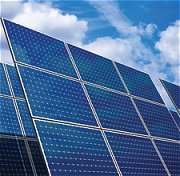
also known as solar panels which are used in the generation of electricity
for commercial and residential applications.
Types
Roof Mounted PV Module Array systems are about the most preferred method of installation in locations where the space is limited or the out doors are not
suitable due to shading, landscaping etc.
The roof mounted domestic PV modules generally used are;
• Single or Multi crystalline silicon PV modules (Panels and Arrays)
and,
• Thin film shingles, Tiles and Peeland –Stick laminates (for Standing seem metal roofs) etc.
All these are durable and are built to withstand hail, wind forces; roof top heat etc encountered in general applications.
Most carry a 20-25 years warranty and can last over 40 years easily .(The older versions installed 40 years ago are still in operation in many countries).
Pros and Cons
Crystalline Modules-Pros
• The quantity of Crystalline PV modules needed for a particular installation is invariably less than thin film shingles.
• The number of water proof membrane piecing is less-It is only the number of arrays.
• Occupy less roof space and in a retrofit needs little roof modification.
Crystalline Modules-Cons
• Looks some what ungainly unless careful redesign is done to roofs.
• The extra weight adds about 10 Lbs per sq. ft to the roof load which needs careful consideration in a retrofit with old supports designed for live and dead roof loads only.
• Cannot accommodate different sun inclinations once installed and are installed facing the best direction under the circumstance.
• Less suited for high temperatures
• The use of Stainless Steel edge trimmings and mounts make it resistant to rigors of adverse weather but makes it expensive.
• Are Cumbersome during installation.
• The tint of the solar cells may not agree with the rest of the roof.
• Shipping is cheaper.
Thin film shingles -Pros
• The former is about twice heavy as the singles having the same area.
• The Thin film shingles are easy to handle at site and on roof..
• As the singles cover the whole pitched roof the shingles can handle changes in solar inclination and incidence better.
• Less susceptible to shading, dust settlement etc. and needs little maintenance.
• As the quantity is more shipping charges are high.
• No need for additional roofing tiles or shingles saving that cost during new constructions.
• Non standard profiles are possible due to their flexibility.
• Less susceptible to mechanical damage.
• Better suited for extreme temperatures.
• The light weight makes it more suited for retrofitting old buildings ( generally 1920 to 1995)
Thin film shingles -cons
• Expensive in terms of material and labor.
• Though the mechanical installation is simplified and standardized, the electrical cabling needs a lot of water proofing membrane breechings.
• More cabling is required for installation
• Incident solar energy to Electricity conversion is less.
• Currently the production capacity of manufacturers is limited and delivery period is long.
The roof mounted PV Module Arrays are varied as it is and newer technologies are too fast being developed. By 2025 most of the developed world on either side of the pacific wants to see at least 40% of their energy being provided by Alternative sources. The sooner we all contribute our mite towards this logical goal; the better will be the benefits for everyone on this planet.
Thanks the Techstore Team